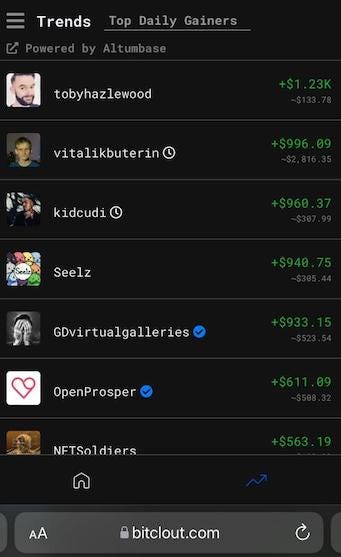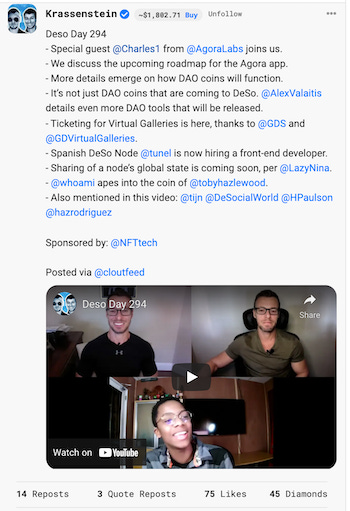How To Make Money on BitClout - A Decentralized Web3 Social Media Platform
Finally, a reason to post something other than selfies or cat videos

The term ‘Web3’ has come to represent the next era of web-based technology.
Its emergence seems to have coincided with a collective backlash against social media platforms like Facebook and Twitter that have monopolized our attention and monetized our data for far too long. Whether Web3 lives up to the hype and expectation and resolves this issue remains to be seen.
But Web3 isn’t just a rebellion against big-tech. It’s synonymous with the growth of Artificial Intelligence and the rise blockchain technology. It’s about the emergence of the metaverse, not as an expression of the will of Mark Zuckerberg and other tech leaders, but rather in the hands of the wider public.
And while the technology matures and formal definitions are agreed upon, many are experimenting in the Web3 space and learning first hand how they can leverage it for their own advantage.
That’s what I’m doing anyway; experimenting. Another, more accurate word for it might be ‘playing’.
In this post I want to share my recent experiences using a Web3 social media platform - BitClout - to illustrate some of the greatest potential benefits that could arise from the new online paradigm:
A renewed focus on mutually enriching online relationships through the thoughtful exchange of valuable information and considered content.
Abundant opportunities for us all to monetize our human capital - our skills, knowledge and expertise with unprecedented ease, using Web3 innovations like NFTs and creator coins as a means of tokenizing ourselves and our output.
Through my experimentation I’ve learned that these are already within the reach of the average social media user if they’re willing to divert their attention and time towards the Web3 ecosystem.
The evolution of the web
Web1 was an online world of largely static information. Pages were published for others to read and consume and transactions between people online were largely one-way; a push of information. If you disagreed with something I’d published on the web, you might send me a snotty email or publish on your own website to express your disagreement. By and large, considered dialogue and genuine, meaningful online-interaction were lacking.
Web2 is synonymous with modern day social media and the numerous online communities and platforms where users interact and communicate on a daily basis.
In a Web2 world, groups don’t merely push information. We disseminate, discuss, debate and often, disagree. While it’s undoubtedly been a step forwards in establishing an online world where people can interact, we’ve also witnessed the relative ease with which civil discussions can quickly degrade into argument, outrage, trolling, doxing and other toxic forms of interaction.
The other insidious downside of Web2 has been the way that platforms harness, dominate and then monetise our attention and personal data. This valuable insight can then be sold to the highest bidder, sharing our ingrained preferences and prejudices for later exploitation.
Web3 promises an antidote of sorts to many of the issues currently faced with Web2.
In practical terms it’s manifesting as a decentralised, permissionless and trustless version of Web2 where there are no central governing bodies or corporations overseeing the use of the technology, or harvesting and selling our data. Certainly, on the blockchain there’s a lot about us that’s notionally laid-bare - the ledger can be interrogated and interpreted by those with the relevant skills. But there’s no single person, corporation or entity in charge and instead, the users are the platform.
Those users are drawn by promises of greater privacy, autonomy, and ownership of their personal data. Web3 is underpinned by decentralised blockchains that grow and evolve over time but which deliver on these promises.
Critics have pointed out that many of the initial Web3 platforms are backed by venture capital firms (essentially meaning they are owned centrally, at least technically). Jack Dorsey and Elon Musk have both expressed such views.
They are however built on blockchains that are by their nature beyond the control of one single entity or individual.
NFTs and Web3
During 2021 the hype around Non-Fungible Tokens (NFTs) grew exponentially. 2022 has started in much the same way.
The term ‘NFT’ has become synonymous with digital illustrations of bored cartoon apes and pixelated punks. Protecting the originality of digital images and selling collections of such art is only one use-case for NFTs. Many others are emerging that could have far more widespread utility.

NFTs use blockchain networks originally built to sustain cryptocurrencies. The same technology underpins decentralized social network platforms that may eventually replace Twitter and Facebook as the place where humans meet online to share content.
Through experimenting on the Web3 social platform BitClout I’ve learned that it’s easy to mint and sell an NFT based on a social media post as a means of leveraging fair exchange of value between the creator and consumer.
NFTs used in this way could change how we think about posting on social platforms. The technology could help us to enrich the lives of those with whom we interact online, by focusing us on delivering value through what we post and share on social media rather than just sharing for the sake of it.
There’s a great deal of synergy between Web3 and NFTs – both support the notion of a peer-to-peer world where control is decentralized, and creators and buyers transact directly without the permission or oversight of a centralized intermediary or controlling body. I can exchange my creations with you in return for money - we don’t need a marketplace, a gallery or a bank to assist at any stage in the process.
Humble beginnings
The Bitcoin network started out as innovators running nodes that were little more than repurposed laptops devoted to mining Bitcoin and maintaining copies of the blockchain ledger. With growth has come scale and the network today has the immense processing power that utilises the power that Bitcoin’s detractors misguidedly complain about.
The same can be expected to be true for decentralised Web3 platforms and the blockchains that sustain them.
Introducing BitClout
BitClout is a social media platform built upon the Decentralized Social blockchain. Its native cryptocurrency token is $DESO which has an equivalent value quoted in US Dollars and is traded on crypto exchanges like Coinbase.
Every user of BitClout has their own creator coin which has a tradable value in $DESO. My creator coin was valued at $36.24 a few weeks ago, but then rocketed to over $100 in a matter of hours (more on this, later). The most valuable creator coin on the platform is Elon Musk’s and this has been valued at over $20,000 when $DESO prices were high.
Incentivising value creation
Each user’s value is determined by the markets perception of the value the user adds to the ecosystem. If they post valuable content regularly, the price of their creator coin increases as buyers are enticed into taking a stake in their future. Each creator becomes a tradable commodity and those who continually add value can expect to grow their value.
Anyone can buy and sell another creator’s coins (or units of their own), investing in the future of creators whose work they believe in. This exchange of value is fully peer-to-peer.
A writer who publishes witty, interesting or informative posts might at some stage write a book that could become a bestseller. The value of their stock could grow in future, and investors are attracted accordingly.
Someone who makes videos and publishes them for free may eventually make a pay-per-view video or even a feature film. At that point, their coin could appreciate in value too.
Users who post the usual cliche’d rubbish - selfies, photos of their meals, cat videos or quotes attributed to the wrong person - won’t likely gain much in the way of attention. The value of their creator coin would be expected to dwindle.
The Decentralized Social blockchain has a number of apps built upon it which integrate to BitClout. CloutPub for example, allows writers to publish articles on the blockchain which can be shared via BitClout – writers can offer their work for free or for a pay-per-read fee (payable in $DESO).
In addition to ‘liking’ posts which may increase the price of the recipient’s creator coin, users can tip creators with small amounts of $DESO. Posts can be liked (the conventional, Web2 method of providing social validation). Users can also send ‘diamonds’ to other creators in recognition of the value they’ve added to the discourse.
Through these reward mechanisms, creators are incentivized to post high-quality, desirable and valuable content.
Now that $DESO is tradable on exchanges like Coinbase, creators can withdraw their earnings from BitClout and convert this into other currencies like Bitcoin or USD.
Minting an NFT from a social media post
BitClout allows users to mint NFTs on the DeSo blockchain direct from every post they make. The process is simple, quick and intuitive, and offers various configuration options.
A post can be turned into a single NFT or a numbered, limited-edition set.
Creators can opt to receive royalties on future resales, and award royalties from all sales to holders of their creator coin too. This further benefits the creator but also those who’ve invested in that creator’s future.
NFTs can also be created to include encrypted content that can only be accessed by the eventual buyer. This could be a text file or a private URL through which the buyer can access a bonus image, a piece of music, a movie, an app or anything else the creator desires.
In common with minting NFTs on other blockchains, there’s a small network fee to pay, but this amounts to fractions of a penny rather than the hundreds of dollars often incurred on Ethereum.
How I minted mine
My first experimental NFT on Ethereum was minted from a photo I’d taken. I posted a similar photo on BitClout along with an appropriate quote, and decided to mint that as an NFT. Here it is:
I offered my NFT for $5 (0.05 $DESO). I’ve posted many photos on Facebook over the years,but never made a cent from them, the only payback being the hollow social validation from a few likes. The prospect of even $5 for posting a photo online seemed like quite good value!
I set my creator royalty at 5% and the coin-holder royalty to 10%. On selling, 10% of my fees would be split amongst holders of my creator coin (and a share of this would go to me as I hold some of my own coin too). I’d also receive 5% of future sales proceeds if the eventual buyer were to sell it on again.
Selling it
Selling an NFT on a marketplace like OpenSea for hundreds of dollars or more, requires a diligent and focused marketing effort if you’re not already an established creator with a hungry following. Conversely, the sales process on BitClout proved to be relatively easy.
NFTs of social posts will generally be priced much more cheaply than those for sale on blockchains like Ethereum, which helps to persuade buyers. As a creator you’re also connected to a captive audience of followers and connections who’ve signalled that they appreciate your content by following you. It makes selling to them much less daunting.
Just by creating my NFT and posting it to my BitClout feed I immediately attracted a buyer from amongst my following, and it turns out they also held some of my creator coin too. As such, there was a direct financial incentive to them for my notional value to increase.
NFTs for tokenizing human value
NFTs created from social media posts are a useful means of monetizing social output.
Perhaps more significantly, it’s the facility to mint these posts as NFTs quickly and cheaply which incentivizes the generation of valuable and useful content.
This seems far more enriching and value-adding than the emotive, stream-of-consciousness content that has become commonplace on social media platforms. Such content is often posted with the intent of gaining following by evoking emotional responses, rather than genuinely benefitting those who consume it.
There are numerous examples that illustrate how this could be exploited by those posting on the platform, which demonstrate how the technology mutually benefits content creators and consumers alike:
Instead of just posting a selfie showing off their shredded abs, a personal trainer could turn that post into an NFT including an encrypted link to a downloadable exercise plan. A series of NFTs minted from the post could be sold to fill places on an online training program.
A writer could post an excerpt from their new novel as a teaser, and an NFT created from the post could give the buyer access to the first full chapter. The writers most loyal fans would be able to own a stake in that writer’s future success.
Even the person posting a photo of their tasty and nutritious lunch could mint it as an NFT, including a link to the recipe and an instructional video on how to make the meal.
A video of a musician playing one of their compositions could include an encrypted link to downloadable sheet music, or a ticket to see them perform it live (either online or in person).
These are just a few examples where a low-cost NFT could be minted on BitClout to monetize social output, making money for the content creator and delivering greater value for the consumer.
The possibilities are endless, and could redefine how we use social platforms more generally.
Incentivizing value-creation
The premise of NFTs is that the creator and seller offers something that’s appealing and valuable to others. The buyer perceives value and status in ownership of the creation. These same principles hold true for NFTs of social media content as much as they do to NFTs of digital images of mutated apes!
This is just one emerging use-case for Web3. But it illustrates how the technology could be harnessed for real benefit, both for content creators who are looking to monetise their output, and for those who consume the information and would be willing to pay for quality.
If you’re considering experimenting as I did, I hope you’ll be heartened by how easy it was for me to do just that.
Postscript: How my worth on BitClout increased by $1200 in one day
I wrote a recent piece for Insider Magazine that discussed the process of minting and selling NFTs on BitClout. Shortly after the piece was published, another BitClout user shared it to the platform which immediately stimulated a lot of interest.
Various investors took a stake in my creator coin, including - it would seem - a user called ‘WhoAmI’.
After doing some online investigation it appears that I may have attracted the attention of one of the founders of the platform who, in crypto terms, ‘aped in’ to my coin - investing around $1,000 of $DESO in me. I’ve no idea whether this was a thank you for bringing some publicity to the platform via the mainstream tech media, or if they simply picked me at random.
The effect was significant though, in boosting me up the daily leader board of creators whose value increased by the most on that day. In fact, on the day I gained more notional value than accounts supposedly representing Ethereum founder Vitalik Buterin and rapper Kid Cudi!
What that represents in monetary terms is pretty significant. If, on the day I’d cashed out all my own coin holding I would have made a profit of around $2500 on an initial investment of around $200 to fund my experimentation.
It also earned me a mention in the daily video from the Krassenstein Twins - one of the most valuable creator accounts (BitClout’s own version of the Winklevoss Twins?) who release a video round-up of events on the platform and the wider world of blockchain, each day.
Whatever caused my little rise to temporary fame on BitClout, I’m grateful for it. If I can make it here, I can make it anywhere (and so can you!)
Here’s that post:
And in case you haven’t yet signed up to BitClout, here’s that video on YouTube (fast forward to 11:31 to see my 15 seconds of fame!):
If you’re intrigued to learn more, I hope you’ll comment back with your questions or comments. I’ll soon be launching my membership option on Cryptocurrently to provide additional support and in-depth content to subscribers. For now, feel free to have a dig around in my archive of old content - it’s all freely available to everyone.
If you’re keen to learn more about NFTs, consider checking out my eBook which should give you a decent grounding in all aspects of the subject.







